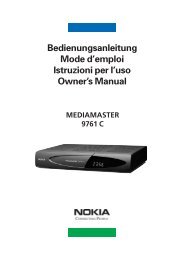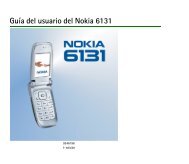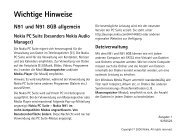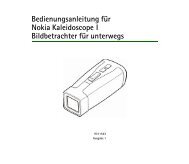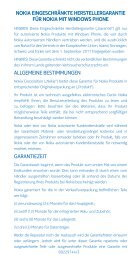Nokia E90 Communicator User Guide
Nokia E90 Communicator User Guide
Nokia E90 Communicator User Guide
Create successful ePaper yourself
Turn your PDF publications into a flip-book with our unique Google optimized e-Paper software.
S e t t i n g s<br />
To set the time-out period after which data calls automatically end if no data has been transferred, select Online time. Select<br />
<strong>User</strong> defined to enter the time yourself or Unlimited to keep the connection active until you select Options > Disconnect.<br />
Session initiation protocol (SIP) settings<br />
Select > Tools > Settings > Connection > SIP settings.<br />
Session initiation protocols (SIP) are used for creating, modifying, and terminating certain types of communication sessions<br />
with one or more participants (network service). SIP profiles include settings for these sessions. The SIP profile used by default<br />
for a communication session is underlined.<br />
To create a SIP profile, select Options > New SIP profile > Use default profile or Use existing profile.<br />
To select the SIP profile you want to use by default for communication sessions, select Options > Default profile.<br />
Edit SIP profiles<br />
Select SIP settings > Options > New SIP profile or Edit, and select from the following:<br />
• Profile name — Enter a name for the SIP profile.<br />
• Service profile — Select IETF or <strong>Nokia</strong> 3GPP.<br />
• Default access point — Select the access point to use for the internet connection.<br />
• Public user name — Enter your user name received from your service provider.<br />
• Use compression — Select if compression is used.<br />
• Registration — Select the registration mode.<br />
• Use security — Select if security negotiation is used.<br />
• Proxy server — Enter the proxy server settings for this SIP profile.<br />
• Registrar server — Enter the registration server settings for this SIP profile.<br />
The settings available for editing may vary.<br />
Edit SIP proxy servers<br />
Select SIP settings > Options > New SIP profile or Edit > Proxy server.<br />
Proxy servers are intermediate servers between a browsing service and its users used by some service providers. These servers<br />
may provide additional security and speed up access to the service.<br />
Select from the following:<br />
• Proxy server address — Enter the host name or IP address of the proxy server in use.<br />
• Realm — Enter the proxy server realm.<br />
• <strong>User</strong> name and Password — Enter your user name and password for the proxy server.<br />
• Allow loose routing — Select if loose routing is allowed.<br />
• Transport type — Select UDP or TCP.<br />
• Port — Enter the port number of the proxy server.<br />
Edit registration servers<br />
Select SIP settings > Options > New SIP profile or Edit > Registrar server.<br />
Select from the following:<br />
• Registrar server address — Enter the host name or IP address of the registrar server in use.<br />
• Realm — Enter the registrar server realm.<br />
• <strong>User</strong> name and Password — Enter your user name and password for the registrar server.<br />
• Transport type — Select UDP or TCP.<br />
• Port — Enter the port number of the registrar server.<br />
Net call settings<br />
Select > Tools > Settings > Connection > Internet tel..<br />
To create a new net call profile, select Options > New profile.<br />
To edit an existing profile, select Options > Edit.<br />
Configurations<br />
Select > Tools > Settings > Connection > Configurations.<br />
You can receive messages from your service provider or company information management containing configuration settings<br />
for trusted servers. These settings are automatically saved in Configurations. You may receive configuration settings for access<br />
points, multimedia, or e-mail services, and IM or synchronization settings from trusted servers.<br />
© 2007 <strong>Nokia</strong>. All rights reserved. 70



